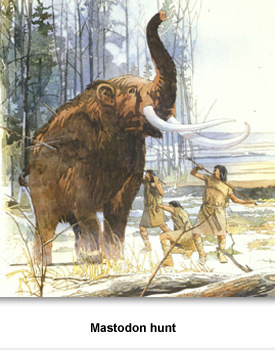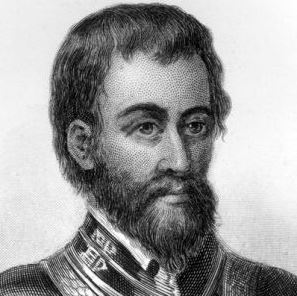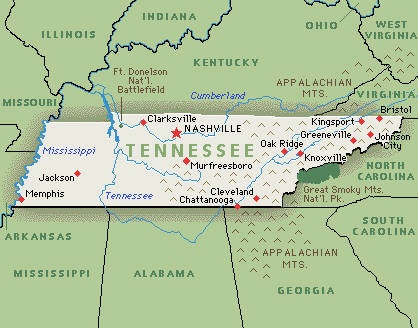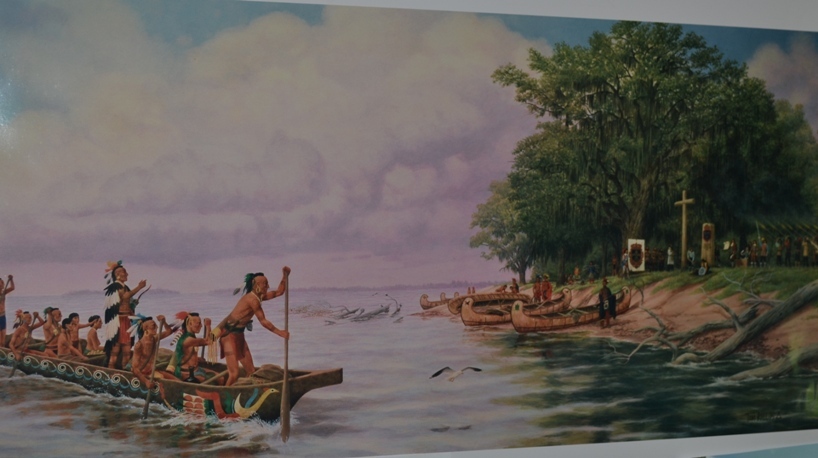Skip to: 1000 CE | 1440 | 1500 | 1530 | 1550 | 1580 | 1600 | 1620 | 1640 | 1680 | 1700 | 1730 | 1750 | 1760 | view in Spanish
3000–1800 BCE
The oldest civilization in the Americas: Norte Chico located in the northern part of Peru.
2000 BC – 900 BCE
Mayan Civilization, Guatemala.
3000-900 BCE
![]() Specifically in the territory of Tennessee, evidence exists of primitive people dating back to 12,000 to 15,000 years with the retreating glaciers during the Ice Age. The Paleo-indians were nomadic people that lived in caves and rock shelters, hunting mastodons and caribou. As the climate temperatures warmed, vegetation changed which attracted large quantities of moose and deer.
Specifically in the territory of Tennessee, evidence exists of primitive people dating back to 12,000 to 15,000 years with the retreating glaciers during the Ice Age. The Paleo-indians were nomadic people that lived in caves and rock shelters, hunting mastodons and caribou. As the climate temperatures warmed, vegetation changed which attracted large quantities of moose and deer.
![]() Between 3,000 and 900 BC early evidence shows examples of the cultivation of agriculture creating a secure food supply and the groups began combining to form villages.
Between 3,000 and 900 BC early evidence shows examples of the cultivation of agriculture creating a secure food supply and the groups began combining to form villages.
1500 BCE
Zapotec Civilization, Mexico.
1200–400 BCE
![]() Olmec Civilization, Mesoamerica.
Olmec Civilization, Mesoamerica.
900–300 BCE
Chavín Civilization, Peru.
914 BCE
Guatemala – Classic period of Mayan culture.
900-1600 CE
![]() The peak of prehistoric cultural development occurred during the Mississippian Culture (900-1600 Current Era). New strains of corn and beans were cultivated for the increase in the population. Ceremonial mounds were built. The sophisticated production of personal items and pottery are indicators of the complex society of the last prehistoric inhabitants of Tennessee.
The peak of prehistoric cultural development occurred during the Mississippian Culture (900-1600 Current Era). New strains of corn and beans were cultivated for the increase in the population. Ceremonial mounds were built. The sophisticated production of personal items and pottery are indicators of the complex society of the last prehistoric inhabitants of Tennessee.
1000–1533 CE
Purépecha Civilization (Tarascan) Michoacan, Mexico.
1319-50 CE
Mexico – Construction of the Aztec capital Tenochtitlan-Tlatelolco
1420
Mexico – Formation of the Triple Alliance, base of the Aztec expansion
1440
Peru- Expansion of the Incan Empire.
1487
Mexico- Dedication of the Great Temple or Gran Templo in Tenochtitlan.
1492
First trip by Christopher Columbus to the Americas.
1493
Second trip by Christopher Columbus. Establishment of the first colony on the island of Hispaniola.
1496
Dominican Republic – Foundation de Santo Domingo, the first European city in the Americas.
1498
Third trip by Columbus. First confirmed visit by Europeans to the coast of South America.
1500
Brazil – Discovery of Brazil, January 26th, by the Spaniard Vicente Yáñez Pinzón. The Brazilian history maintains that the discovery was made by the Portuguese Pedro Alvarez Cabral.
1502
Fourth trip by Columbus. Discovery of the Central American coast.
1506
Christopher Columbus dies.
1508
Puerto Rico – Juan Ponce de León conquers Puerto Rico.
Hispaniola, Juan de Esquivel takes over Jamaica and Alonso de Hojeda leads an expedition to the coast of Venezuela and Colombia.
1511
Cuba – Diego Velaquez de Cuellar conquers Cuba.
First Spanish settlement on American soil: Santa María la Antigua de Darién (Colombia).
1513
Ponce de León claims Florida for España.
1516
Uruguay – Arrival of Spanish.
1516-18
Spanish expedition to the eastern coast of Mexico.
1519
The cities of Panama and Veracruz are founded.
1518-21
Mexico – Hernan Cortes conquers the Aztecs in the name of Spain.
1523
Guatemala -The Spanish conquistador, Pedro de Alvarado, subjugates the native people from the mountain regions.
1528-30
Guatemala – Pedro de Alvardo conquers Guatemala.
1530
Mexico – Cortés is given the title of Marquez of the Valley of Oaxaca while in Spain.
1531
Ecuador – The Spanish arrive under the command of Francisco Pizarro.
1531-6
Mexico – The first silver deposits are discovered; pedal-driven looms are imported.
1532
Ecuador – Pizarro, with new reinforcements, confronts with Incas and their leader, Atahualpa. The Battle of Cajamarca (in Peru). Atahualpa is taken prisoner.
1533
Peru – Atahualpa is assassinated. Pizarro captures Cuzco.
1534
Ecuador – The city of San Francisco de Quito is established on the ruins of the Incan capital.
1538
Peru – Francisco Pizarro conquers the Incas in the name of Spain.
1539
![]() Hernando De Soto arrived in Tampa Bay, Florida with 13 pigs. was born in Spain to a noble but poor family. From a very young age, he learned the strategies of the explorers of the Caribbean and Central America (plundering and seizure of slaves), and then as a captain under Francisco Pizarro, he engaged in the conquest of Peru.
Hernando De Soto arrived in Tampa Bay, Florida with 13 pigs. was born in Spain to a noble but poor family. From a very young age, he learned the strategies of the explorers of the Caribbean and Central America (plundering and seizure of slaves), and then as a captain under Francisco Pizarro, he engaged in the conquest of Peru.
![]() De Soto landed at what is known today as Charlotte Harbor, Florida (Gulf Coast), with a military detachment of 640 volunteers, an average age of twenty-four years old, selected to establish a Spanish colony near the Mississippi River. Along with the men, he brought 200 horses, many dogs, various weaponry and sufficient supplies for the project. Ideally, the location like Mexico City would provide the opportunity to pillage silver and gold. Many Europeans had already tried a similar settlement but none on such a large scale and none had succeeded.
De Soto landed at what is known today as Charlotte Harbor, Florida (Gulf Coast), with a military detachment of 640 volunteers, an average age of twenty-four years old, selected to establish a Spanish colony near the Mississippi River. Along with the men, he brought 200 horses, many dogs, various weaponry and sufficient supplies for the project. Ideally, the location like Mexico City would provide the opportunity to pillage silver and gold. Many Europeans had already tried a similar settlement but none on such a large scale and none had succeeded.
1540
![]() After the spending the winter in northern Florida and with news of gold in the direction of the rising sun, De Soto headed northeast in the Spring of 1540, crossing Alabama, Georgia and the Carolinas. With no success of finding gold, he returned to the west, entering Tennessee, Georgia and Alabama while trying to return to Mobile Bay to meet his ships. However, in October of 1540, the chief of the Tuscaloosa tribe ambushed De Soto’s army one hundred miles from the port. In spite of the leaving victorious, De Soto withdrew to the the north, past the Tennessee River so his men would be isolated and unable to escape to the ships. http://discoverkingsport.com/h-Cherokee-early.shtml
After the spending the winter in northern Florida and with news of gold in the direction of the rising sun, De Soto headed northeast in the Spring of 1540, crossing Alabama, Georgia and the Carolinas. With no success of finding gold, he returned to the west, entering Tennessee, Georgia and Alabama while trying to return to Mobile Bay to meet his ships. However, in October of 1540, the chief of the Tuscaloosa tribe ambushed De Soto’s army one hundred miles from the port. In spite of the leaving victorious, De Soto withdrew to the the north, past the Tennessee River so his men would be isolated and unable to escape to the ships. http://discoverkingsport.com/h-Cherokee-early.shtml
![]() The first contacts with the Europeans with Native American societies had a devastating effect due to the pillaging and the introduction of diseases to which the indigenous population lacked immunity. The social order of the native societies suffered an irreversible change. Those that survived, little by little reorganized into tribes that today we know was Creek, Choctaw, Chicaksaw, Cherokee and Catawba.
The first contacts with the Europeans with Native American societies had a devastating effect due to the pillaging and the introduction of diseases to which the indigenous population lacked immunity. The social order of the native societies suffered an irreversible change. Those that survived, little by little reorganized into tribes that today we know was Creek, Choctaw, Chicaksaw, Cherokee and Catawba.
![]() During the 150 years after De Soto, these new tribes moved to distinct regions of Tennessee. The powerful Cherokees settled on the banks of the Hiwassee River and the Little Tennessee River. The Chickasaw ruled the lands west of the Tennessee River. The Shawnee settled to the south near the Cumberland River.
During the 150 years after De Soto, these new tribes moved to distinct regions of Tennessee. The powerful Cherokees settled on the banks of the Hiwassee River and the Little Tennessee River. The Chickasaw ruled the lands west of the Tennessee River. The Shawnee settled to the south near the Cumberland River.
1541
Colombia – Santa Fe de Bogota is established.
1542
![]() Hernando De Soto dies of a fever in Louisiana.
Hernando De Soto dies of a fever in Louisiana.
1546
Chile – The city of Santiago is established.
1551
Mexico – Andres de Olmos published the first grammar of the Nahuatl language.
1555
Brazil – France establishes a colony (France Anartique) in the location of today’s Rio de Janeiro.
1567
![]() The Spanish explorer Captain Juan Pardo was the first to use the word Tennessee during an expedition during the summer of 1567.
The Spanish explorer Captain Juan Pardo was the first to use the word Tennessee during an expedition during the summer of 1567.
1580
Peru and Mexico – The first universities in Lima and Mexico City were established.
1595
Puerto Rico – The English corsair, Francis Drake, plundered the city of San Juan.
1598
Puerto Rico – The British navy invaded the island and then abandoned it in six months.
1606
Argentina – Juan de Garay established Buenos Aires.
Bolivia – The silver boom in Oruro began.
1610
Paraguay – The Jesuits began their first mission among the Guarani.
1624
Uruguay – The first permanent Spanish colony was founded, Soriano on the Rio Negro.
1625
Puerto Rico – The Dutch attacked San Juan and set fire to the city.
1641
Venezuela – The earthquake of San Bernabe destroyed most of Caracas and the nearby settlements.
1673
![]() The Europeans resumed exploration of the region. The English merchants James Needham and Gabriel Arthur from Charles Town, South Carolina, crossed the Appalachian mountains to establish trade with the Cherokee in eastern Tennessee. The French progressed from the west lead by Father Jacques Marquette and the fur trader Louis Jolet, descended the Mississippi River. Both constructed strong arguments claiming the right to lands to the west of the Appalachian Mountains.
The Europeans resumed exploration of the region. The English merchants James Needham and Gabriel Arthur from Charles Town, South Carolina, crossed the Appalachian mountains to establish trade with the Cherokee in eastern Tennessee. The French progressed from the west lead by Father Jacques Marquette and the fur trader Louis Jolet, descended the Mississippi River. Both constructed strong arguments claiming the right to lands to the west of the Appalachian Mountains.
1674
French Guyana – The French crown took control (Equinoctial France), named a governor and it became a colony of France with the capital of Cayenne.
1679
Mexico – Uprising of the Pueblo Indians 1679-1693
1682
![]() The French General La Salle built Fort Prudhomme (near Memphis), the first structure by a white man in Tennessee.
The French General La Salle built Fort Prudhomme (near Memphis), the first structure by a white man in Tennessee.
1714
![]() M. Charleville, a French trader from New Orleans, established a trading post in gorge called French Lick (today’s Nashville).
M. Charleville, a French trader from New Orleans, established a trading post in gorge called French Lick (today’s Nashville).
1730
![]() Sir Alexander Cummings, sent by the British Government, negotiated the first treaty between the English and the Cherokee. A group of seven Cherokee chiefs traveled with him to England to declare loyalty to the king.
Sir Alexander Cummings, sent by the British Government, negotiated the first treaty between the English and the Cherokee. A group of seven Cherokee chiefs traveled with him to England to declare loyalty to the king.
![]() Another explorer, Dr. Thomas Wather, was sent by the Loyal Land Company of Virginia and named the Cumberland Mountains and the Cumberland River in honor of the Duke of Cumberland, then Prime Minister of England.
Another explorer, Dr. Thomas Wather, was sent by the Loyal Land Company of Virginia and named the Cumberland Mountains and the Cumberland River in honor of the Duke of Cumberland, then Prime Minister of England.
Bolivia – Uprising of the Mestizos in Cochabamba.
1746
Mexico – Our Lady of Guadalupe is proclaimed Patron Saint of New Spain.
1750
![]() History tells us that the first person to use the world Tennessee with the current spelling was the Governor of South Carolina (1750), James Glen. Also, it is believed that Andrew Jackson was the one who proposed the name Tennessee when it joined the Union. However, public records indicate that Daniel Smith, secretary of the old Southwest Territory, proposed the first draft of the constitution for the formation of the new state, called, “the name of the New State of Tennessee.” http://www.tngenweb.org/campbell/hist-bogan/tennessee.html
History tells us that the first person to use the world Tennessee with the current spelling was the Governor of South Carolina (1750), James Glen. Also, it is believed that Andrew Jackson was the one who proposed the name Tennessee when it joined the Union. However, public records indicate that Daniel Smith, secretary of the old Southwest Territory, proposed the first draft of the constitution for the formation of the new state, called, “the name of the New State of Tennessee.” http://www.tngenweb.org/campbell/hist-bogan/tennessee.html
1756
![]() The Mayor Andrew Lewis built Fort Virginia near Echota, on Cherokee land, 25 miles southwest of Knoxville. Not much time passed before the Native Americans destroyed the fort.
The Mayor Andrew Lewis built Fort Virginia near Echota, on Cherokee land, 25 miles southwest of Knoxville. Not much time passed before the Native Americans destroyed the fort.
![]() The English built Fort Loudon (in what now is Vonore, Tennessee), with the intention of keeping the Cherokee loyalty divided. The plan failed and in 1760, the Cherokee surrounded the fort and finally assassinated most of the captives. In spite of that English disaster, the French lost the war and all of their leverage in North America and ceded to the English who claimed the right to all the lands east of the Mississippi River.
The English built Fort Loudon (in what now is Vonore, Tennessee), with the intention of keeping the Cherokee loyalty divided. The plan failed and in 1760, the Cherokee surrounded the fort and finally assassinated most of the captives. In spite of that English disaster, the French lost the war and all of their leverage in North America and ceded to the English who claimed the right to all the lands east of the Mississippi River.
1761
![]() Peace was established between the English and Cherokee.
Peace was established between the English and Cherokee.
![]() The Long Hunters explored eastern Tennessee and the Cumberland Gap, contracted by the Henderson Company of North Carolina. They are called the Long Hunters because of the long period of time of their hunting expeditions up to two years.
The Long Hunters explored eastern Tennessee and the Cumberland Gap, contracted by the Henderson Company of North Carolina. They are called the Long Hunters because of the long period of time of their hunting expeditions up to two years.
1763
![]() Proclamation of 1763 forbade all settlement to the west of the Appalachians.
Proclamation of 1763 forbade all settlement to the west of the Appalachians.
![]()
Cuba – 1762-63 English occupation.
1765
![]() Ecuador – Uprising in Quito against the rising fiscal pressure.
Ecuador – Uprising in Quito against the rising fiscal pressure.
1769
The first settler in Tennessee. William Bean, supposedly the first permanent settler in Tennessee built a cabin on Boone’s Creek near the Watauga River.
Next page>>>






